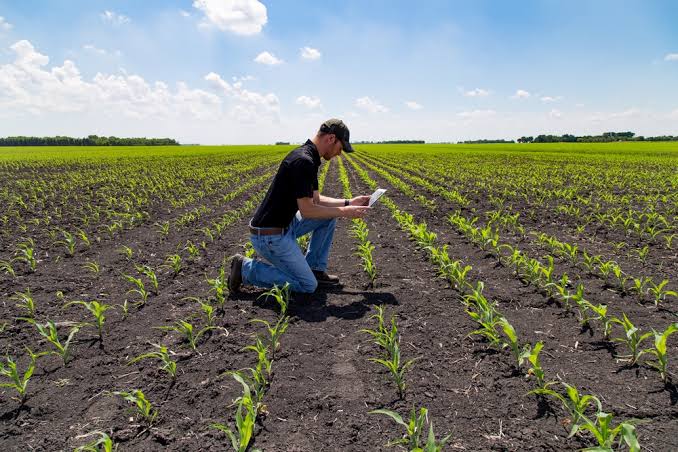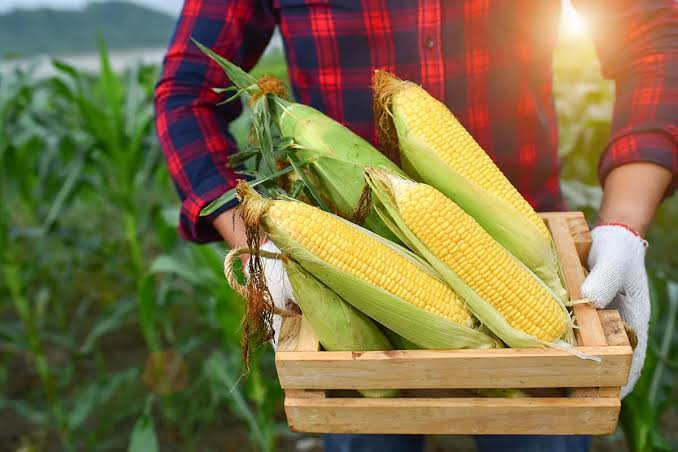Planting corn involves a series of steps to ensure a successful crop. Begin by selecting a suitable site with well-draining soil and ample sunlight. It’s important to prepare the soil by removing weeds and rocks. Plow or till the soil to create a loose and fertile bed for the corn seeds.
Once the soil is ready, choose high-quality corn seeds from a reliable source. Plant the seeds at the recommended depth, usually around 1 to 2 inches deep, and space them according to the variety’s guidelines. Cover the seeds with soil and water the area gently to provide moisture for germination.
Corn requires consistent watering throughout its growing period. Water the plants when the soil feels dry to the touch, and avoid overwatering to prevent root rot. Mulching around the base of the plants can help retain moisture and suppress weeds.
Fertilize the corn plants with a balanced fertilizer to provide essential nutrients for healthy growth. Follow the recommended application rates and timings for optimal results. Monitor the plants for any signs of pests or diseases, and take prompt action if needed to protect the crop.
As the corn plants grow, consider providing support if they are tall varieties prone to lodging. This can be done by gently tying the stalks to stakes. Additionally, thin out the weaker seedlings to give more space and resources to the stronger ones, promoting better yields.
Harvesting corn is a crucial step in the process. Determine the right time by observing the corn ears; they should be filled out with plump kernels. Harvest by gripping the ear and twisting it slightly, then pulling downward to detach it from the stalk. Store the harvested corn in a cool, dry place.
In addition, planting corn involves careful site selection, soil preparation, seed planting, watering, fertilizing, pest management, and harvesting. Following these steps diligently can lead to a successful corn crop, providing a bountiful harvest for your enjoyment.
Read Also: Principles of Reproduction in Rabbits
Comprehensive Guide of Planting Corn

Planting corn is a comprehensive process that involves several key steps to ensure a successful crop. Let’s delve into the intricacies of each stage:
1. Site Selection: Choosing the right location is crucial for corn cultivation. Opt for a site with well-draining soil and ample sunlight. Corn thrives in full sun, so select a spot that receives at least 6-8 hours of direct sunlight per day. Ensure the soil is rich in nutrients and has good drainage to prevent waterlogging.
2. Soil Preparation: Prepare the soil by removing weeds, rocks, and debris. Plow or till the soil to create a loose and aerated bed. This facilitates better root development and nutrient absorption for the corn plants. Adequate soil preparation sets the foundation for a healthy crop.
3. Seed Selection: Select high-quality corn seeds from a reputable source. Consider factors such as seed variety, disease resistance, and local climate conditions. Read and follow the guidelines provided by the seed supplier regarding planting depth, spacing, and other specific requirements.
4. Planting: Plant the corn seeds at the recommended depth, typically around 1 to 2 inches deep. Follow the spacing guidelines for the chosen corn variety. Cover the seeds with soil and water the area gently. Adequate moisture is essential for germination. Monitor soil moisture levels regularly during the germination phase.
5. Watering: Corn plants require consistent watering throughout their growth cycle. Water the plants when the soil feels dry to the touch. However, avoid overwatering, as excessive moisture can lead to root problems. Mulching around the base of the plants helps retain soil moisture and suppress weeds.
6. Fertilization: Fertilize the corn plants to provide essential nutrients for optimal growth. Use a balanced fertilizer and follow recommended application rates. Fertilize at key stages of the corn’s development, such as during planting, early growth, and when the plants start to form ears.
7. Pest and Disease Management: Monitor the corn plants regularly for signs of pests or diseases. Common issues include corn borers, aphids, and fungal diseases. Implement preventive measures and, if necessary, use appropriate pesticides or organic alternatives to protect the crop.
8. Plant Support: For tall corn varieties prone to lodging, provide support by tying the stalks to stakes. This helps prevent the plants from bending or breaking during adverse weather conditions.
9. Thinning: Thin out weaker seedlings to provide more space and resources for the stronger ones. Proper spacing between plants promotes better air circulation and reduces competition for nutrients, leading to healthier plants.
10. Harvesting: Determine the right time to harvest by observing the corn ears. They should be filled out with plump kernels. Harvest by gripping the ear and twisting it slightly, then pulling downward to detach it from the stalk. Store the harvested corn in a cool, dry place.
By following these comprehensive guidelines, you can increase the likelihood of a successful corn crop, from planting to harvesting. Each step plays a vital role in ensuring optimal growth and a bountiful harvest.
Read Also: Processes involved in Rabbit Marketing
Economic Benefits of Planting Corn

Planting corn can bring many good things for the economy. Let’s talk about why growing corn is helpful for making money and supporting people.
1. People Want Corn: Many people like to eat corn, and companies use it in different foods. When farmers grow corn, they can sell it to these companies. This helps farmers earn money because there is a high demand for corn.
2. Jobs for People: When farmers grow corn, they need help to take care of the fields and harvest the corn. This creates jobs for people in the farming industry. More jobs mean more people can work and earn a living.
3. Money from Selling Corn: Farmers sell the corn they grow, and this brings in money for them. This money helps them take care of their families, buy things they need, and invest in their farms.
4. Selling Corn to Other Countries: Some countries grow less corn than they need. Farmers can sell their extra corn to these countries. This is called exporting. Exporting corn helps a country make money from selling to other places.
5. Helping Animals Grow: Corn is used to make food for animals like cows and chickens. When farmers grow corn, it supports the livestock industry. This industry provides meat and other products, creating more economic opportunities.
6. Making Things from Corn: Corn isn’t just for eating. It is used to make different products like corn oil and corn starch. Companies can sell these products, and this adds value to the corn industry.
7. Helping the Environment: Growing corn can be good for the environment. Farmers use corn in crop rotation, which means they grow different crops in the same area. This helps keep the soil healthy and reduces the need for harmful chemicals.
8. Growing the Economy in Rural Areas: Many corn farms are in rural areas. When farmers grow corn, it brings economic development to these regions. It creates businesses and improves the living conditions of people in rural communities.
9. Making Fuel from Corn: Corn is used to make biofuel, a kind of renewable energy. This helps reduce dependence on non-renewable energy sources. Growing corn for biofuel supports the environment and the economy.
10. Government Support and Taxes: Governments often support farmers, and taxes from the corn industry contribute to public funds. This money can be used for building infrastructure and supporting other important needs.
In addition, planting corn is like planting seeds for economic growth. It provides food, jobs, and products that people want. The economic benefits of growing corn reach far and wide, making it an important crop for many communities and countries.
Uses of Corn
Corn is a versatile crop with various uses, contributing to a wide range of products and industries. Here are some common uses of corn:
1. Food Products: Corn is a staple in many diets worldwide. It is used in various forms, including fresh corn on the cob, canned corn, cornmeal, corn flour, and corn oil.
2. Animal Feed: Corn is a major component of animal feed. It provides essential nutrients for livestock, poultry, and other animals, supporting their growth and health.
3. Biofuel Production: Corn is used to produce ethanol, a biofuel. Ethanol is blended with gasoline to create bioethanol, a renewable energy source that reduces dependence on fossil fuels.
4. Industrial Products: Corn is used in the manufacturing of industrial products such as starch, corn syrup, and corn-based sweeteners. These products have applications in the food and beverage industry, as well as in the production of various goods.
5. Corn Starch: Corn starch is extracted from corn and has multiple uses. It is used as a thickening agent in cooking and baking and is also utilized in the production of adhesives, textiles, and paper.
6. Corn Oil: Corn oil is extracted from corn kernels and is commonly used in cooking and food preparation. It is also used in the production of salad dressings, margarine, and various processed foods.
7. High-Fructose Corn Syrup (HFCS): HFCS is a sweetener derived from corn and is used extensively in the food and beverage industry. It is an ingredient in soft drinks, candies, and many processed foods.
8. Corn-based Snacks: Corn is a primary ingredient in the production of snacks such as popcorn, corn chips, and corn-based cereals. These products are popular snacks enjoyed by people worldwide.
9. Corn Gluten Meal: Corn gluten meal, a byproduct of corn processing, is used as a natural herbicide and fertilizer. It helps control weeds in lawns and gardens.
10. Pharmaceutical and Industrial Uses: Corn-derived products are used in pharmaceuticals, cosmetics, and various industrial applications. Cornstarch may be used in the production of pharmaceutical tablets, and corn-based ingredients are found in some cosmetic products.
11. Decorative and Craft Uses: Corn husks and stalks are often used in crafts and decorations. Corn husk dolls and corn husk wreaths are examples of traditional crafts.
12. Soil Enrichment and Crop Rotation: Corn is a valuable crop for farmers practicing crop rotation. It helps improve soil fertility and structure, benefiting subsequent crops.
The diverse uses of corn highlight its significance in agriculture, industry, and daily life. From being a fundamental food source to contributing to bioenergy and various industrial products, corn plays a crucial role in global economies and communities.
Read Also: Definitions, Concepts and Types of Sewage and Sewerage
